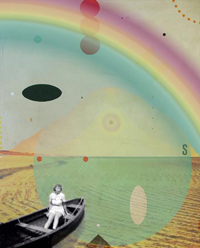![]() By Roy H. Williams
By Roy H. Williams
Minor key life is the mournful echo of a hollowed-out gourd, bleached in the sun, hard and empty. Life should be lived in a major key, drenched in the colors of nature, quivering with energy, throbbing with purpose.
Last week I showed you how to extract liquid color palettes from famous paintings. This week I’ll show you a similar technique using words. It’s the one taught by Christopher J. Maddock* in Accidental Magic, chapter 15, “How to Color Your Writing.” Master this technique and you’ll wring vivid dictionaries from a single word.
Here’s Professor Maddock’s instruction:
“First, choose an emotion or feeling to communicate, such as nervous excitement. Think of some words or phrases you associate with that feeling: anxious, waiting, white-knuckled, hesitant, cold sweat. Now incorporate these into your writing:
You step into your waiting car, failing to ward off the thought: ‘My first house.’ The seatbelt clutching your shoulder: ‘My first house.’ Engine hesitant, tires chirping, you drive white-knuckled through a cold sweat of rain toward a place you’ve been waiting to come home to your entire life.
Voilà! Color your ads with emotions. Enliven them with words fat with association. Don’t just paint pictures – give rides.”
In the opening paragraph of today’s memo I gave you a series of words I associate with minor key music. But rather than say the obvious, “sad, melancholy, and pale,” I went one level deeper and gave you my associations with those words: “mournful, hollowed-out, bleached in the sun.”
Maddock’s technique helps you to avoid clichés and surprise your audience with unexpected combinations and layers of meaning. Listeners and readers love it.
I’ve often said to the students of writing at Wizard Academy, “A willingness to write badly is the key to writing well.” When writing descriptions, the first words to pop into your head will be the ones you hear most often, the ones that are overused. Capture these words on paper, then think of what you associate with each of them.
Don’t use the obvious words. Use the associations. Don’t worry that your audience won’t understand. Write colorfully and you, too, might be nominated to become president of Chile.
“Julian once told me that a story is a letter the author writes to himself, to tell himself things that he would be unable to discover otherwise.” – Carlos Ruiz Zafon, The Shadow of the Wind, p. 444
Pablo Neruda was never afraid that his audience wouldn’t understand. That’s what made his writing so colorful:
“Anyone who doesn’t read Cortázar is doomed. Not to read him is a grave invisible disease which in time can have terrible consequences. Something similar to a man who had never tasted peaches. He would be quietly getting sadder, noticeably paler, and probably little by little, he would lose his hair. I don’t want those things to happen to me, and so I greedily devour all the fabrications, myths, contradictions, and mortal games of the great Julio Cortázar.” – Pablo Neruda, poet, nominated as a candidate for the Chilean presidency in 1970.
You’ve tasted a peach, haven’t you?
Write colorfully. If you don’t, you’ll lose your hair.
♦

